Middleware for Mobile Social Ecosystems
Motivation
With the increased prevalence of advanced mobile devices (the so-called “smart” phones), interest has grown in mobile social ecosystems (MSEs), where users not only access traditional Web-based social networks using their mobile devices, but are also able to use the context information provided by these devices to further enrich their interactions.

Owing to the large variety of platforms available for smart phones, as well as the different ways that data and context information is represented, it is natural to think of middleware solutions that the developers of these systems can use while creating their applications.
The design and development of a middleware support platform for mobile social applications (or a MSE management middleware) is challenging and must address a number of issues:
- Expressive and flexible models to represent MSE. An MSE management middleware should represent multiple aspects of users’ social interactions by providing a comprehensive model that includes additional relations, such as content sharing and tagging, co-location, proximity, group membership, event participation and common interests.
- Privacy-awareness and access control. Mobile social applications manage contextual data, such as mobility traces, user preferences and activities, as well as human relationships, which are sensitive per se and can be further used to infer sensitive information.
- MSE management functionalities. As human relations evolve, data describing MSE must change to represent this dynamics, which might also be due to users' mobility. Functionalities are therefore needed for (a) MSE creation, and (b) MSE updates.
- Fully distributed architecture. Mobile environments are naturally distributed, and users must be able to access their MSE data anywhere and anytime. MSE management middleware should be designed in a fully distributed fashion to exploit mobile ad-hoc connectivity, whenever and wherever available, and without assuming centralized servers.
Research
We are developing a middleware framework for managing mobile social ecosystems. We envisage a multi-layer middleware architecture consisting of modules which will provide the needed functionalities, including:
- Extraction of social ties from context (both physical and virtual)
- Enforcement of access control to protect social data from arbitrary access
- A rich set of MSE management functionalities using which mobile social applications can be developed.
Our middleware adopts a graph-based model for representing social data, where nodes and arcs describe socially relevant entities and their connections. In particular, we exploit the Resource Description Framework (RDF), a basic Semantic Web standard language that allows representing and reasoning about social vocabulary, and creating an interconnected graph of socially relevant information from different sources.
Contributors
Presentations (registered users only)
[Icon credits: Icon Etc.]




